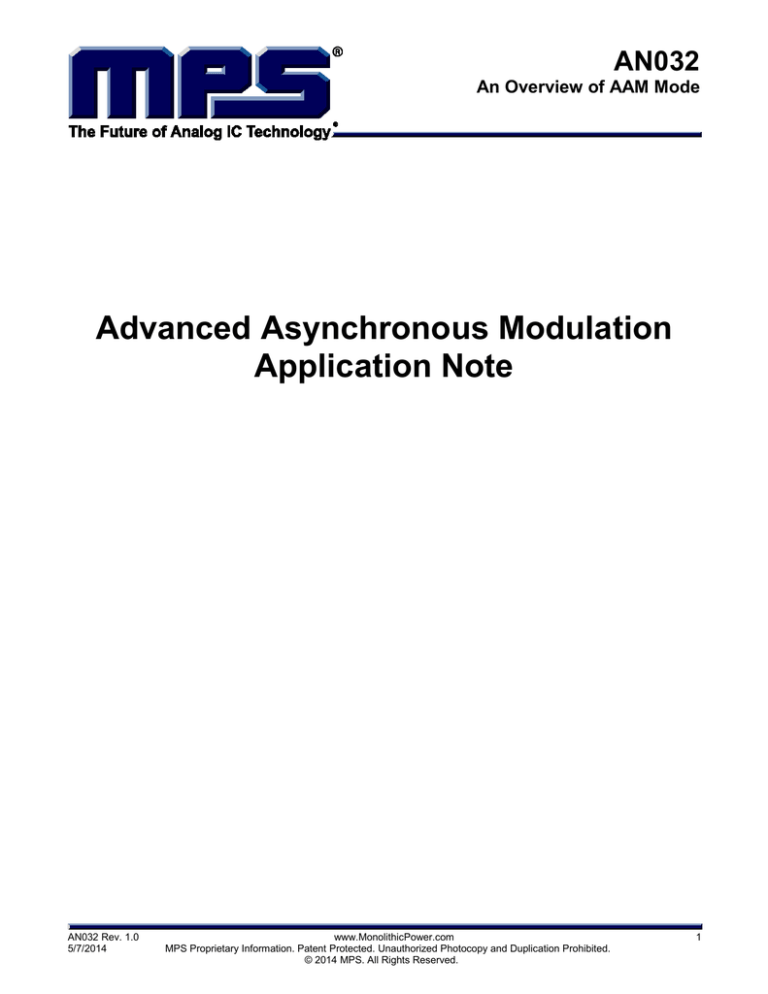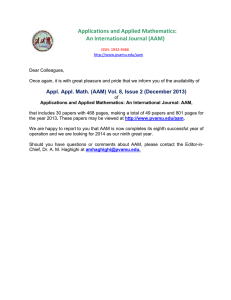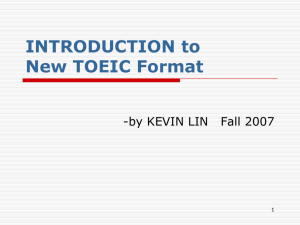
AN032
An Overview of AAM Mode
Advanced Asynchronous Modulation
Application Note
AN032 Rev. 1.0
5/7/2014
www.MonolithicPower.com
MPS Proprietary Information. Patent Protected. Unauthorized Photocopy and Duplication Prohibited.
© 2014 MPS. All Rights Reserved.
1
AN032
An Overview of AAM Mode
ABSTRACT
The increasing demand for high-efficiency and low-power electronics has resulted in rising demand for
power converters—especially DC-DC converters—that operate with pulse-frequency modulation (PFM)
at light-load currents, and pulse-width modulation (PWM) at heavier current loads. This application note
introduces MPS’s proprietary Advanced Asynchronous Modulation (AAM) technology, and includes
sample designs.
Figure 1 shows a typical block diagram of a converter with AAM mode. The block diagram is almost the
same as a step-down converter with a PWM switching frequency of 500kHz, except that under lightload conditions the voltage at the AAM pin sets the PFM mode operation and its load range.
Figure 1: Functional Block Diagram
INTRODUCTION TO AAM CONTROL
The AAM is effectively a function of the output current where the output current (as sensed through a
resistor) is compared against a level set by a voltage applied to the AAM pin: The applied voltage
determines the switching points between PFM and PWM modes. A user can choose an appropriate
transition point that balances between multiple parameters—including switching efficiency, transient
response, power consumption, and output ripple—by setting the AAM voltage (VAAM) through an
external resistor divider.
Figure 2 shows the simplified control logic, and Figure 3 shows the signal diagrams. When the clock
goes high and VCOMP is greater than VAAM, the high-side switch (HS-FET, “HS” in the diagrams) turns
on, Iinductor (as measured from a sense resistor) ramps up until it reaches the COMP level. When Iinductor
reaches COMP, the HS-FET turns off and the low-side MOSFET (LS-FET) turns on to drop Iinductor
below zero when the LS-FET turns off. The internal clock resets every time VCOMP exceeds VAAM and
this period between resets determines the length of the next clock cycle. If the DC value of VCOMP is
less than VAAM and VFB is less than Vref, VCOMP ramps up until it exceeds VAAM: During this time, the
converter can skip some pulses for PFM mode. When the load increases and the DC value of VCOMP is
AN032 Rev. 1.0
5/7/2014
www.MonolithicPower.com
MPS Proprietary Information. Patent Protected. Unauthorized Photocopy and Duplication Prohibited.
© 2014 MPS. All Rights Reserved.
2
AN032-AN OVERVIEW OF AAM MODE
higher than VAAM, the operation mode is discontinuous conduction mode (DCM) or continuous
conduction mode (CCM), which has a fixed switching frequency.
Vout
Vin
Cin
HS
RLoad
R1
C1
Q S
R
VAAM
Vcomp
VFB
Vref
I inductor
R2
Figure 2: Simplified PFM Control Logic
The capacitor C1 between the AAM node and the AAM comparator output adds an AC hysteretic for
the comparator logic: When VCOMP crosses above VAAM, the output of the AAM comparator drops to zero
and C1 causes VAAM to drop; when VCOMP crosses below VAAM, VAAM rises. This AC hysteretic is quite
useful for noise immunity. It avoids multiple VCOMP and VAAM crossings within a short time, which would
cause an ultra-high–switching frequency.
AN032 Rev. 1.0
5/7/2014
www.MonolithicPower.com
MPS Proprietary Information. Patent Protected. Unauthorized Photocopy and Duplication Prohibited.
© 2014 MPS. All Rights Reserved.
3
AN032-AN OVERVIEW OF AAM MODE
V AAM
V AAM
Vcomp
Clock1
Vcomp
Clock2
Clock Reset
Clock Reset
Clock1
Clock2
Clock Reset
Clock Reset
T1
T1
T2
T2
HS
HS
LS
LS
Io
Io
I_inductor
I_ inductor
(a) PFM Under Extreme Light Load
(b) PFM Under Light Load
Vcomp
V AAM
V AAM
Vcomp
Clock1
Clock2
Clock Reset
Clock Reset
T1
T1
T2
HS
HS
LS
LS
Io
Io
I_inductor
I_inductor
(c) PFM Under Heavy Load
(d) CCM Under Heavy Load
Figure 3: PFM and CCM Signal Diagrams
The switching frequency increases as the load increases as shown in Figure 3(a), (b) and (c), where
T1 is the fixed switching period caused by normal 500kHz clock, and T2 is the burst switching period
caused by VCOMP and VAAM.
Under extremely light loads in PFM mode, as shown in Figure 3(a), the DC value of VCOMP is very low
and the VCOMP value swings dramatically. After VCOMP crosses above VAAM, VCOMP falls sharply and the
duration that VCOMP < VAAM is very long, during which the converter skips T1 pulses and the switching
frequency is very low.
Under light-load, as shown in Figure 3(b), the DC value of VCOMP increases over the value under
extremely light loads, and the VCOMP swing is smaller. After VCOMP increases above VAAM, VCOMP
decreases more slowly than under the previous case. Because the duration of VCOMP < VAAM is shorter,
the converter skips fewer T1 pulses, which results in a higher switching frequency.
As shown in Figure 3(c), as the load increases to the medium load range, the DC value of VCOMP
increases, and the duration that VCOMP > VAAM is longer. As a result, the HS-FET turns on at the first
clock reset. The HS-FET is turned on at the fixed 500kHz clock, but the inductor current frequency
AN032 Rev. 1.0
5/7/2014
www.MonolithicPower.com
MPS Proprietary Information. Patent Protected. Unauthorized Photocopy and Duplication Prohibited.
© 2014 MPS. All Rights Reserved.
4
AN032-AN OVERVIEW OF AAM MODE
switches twice as fast, and the output voltage ripple is larger than under light-load. As the inductor
current increases, the two periods in the current switching signals—T1 which is equal to the fixed
switching period of CCM mode, and T2 which is the burst period—equalize, and T1 pulses until the
system enters into DCM or CCM mode completely. When in DCM or CCM mode, only T1 exists as
Figure 3(d) shows.
The AAM hysteretic mode helps to reduce noise at the AAM node that could cause abnormal pulse
groups if the noise occurs as VCOMP rises above VAAM, as shown in Figure 4(a). The effects of the AAM
hysteretic mode can be seen in Figure 4(b).
Test Conditions: VIN=12V, Vo=1.8V, Io=0A,
VAAM (AC)
VAAM (AC)
Vsw
Vsw
IL
IL
(a) Without AAM AC Hysteretic
(b) With AAM AC Hysteretic
Figure 4: AAM AC Hysteretic Can Avoid Noise Influence on AAM Voltage
For PFM control logic—alternatively, constant-peak–current control—VCOMP is clamped by VAAM, so
therefore the peak of Iinductor is also clamped by VAAM. For other control methods, VCOMP increase as the
load current increases: For constant-peak–current control under light load as the load current increases,
VCOMP switches around VAAM, and the converter operates in PFM mode. As the load current increases
and VCOMP rises above VAAM, and the converter operates in DCM and CCM modes. The switching
frequency is fixed to around 500 kHz.
MERITS OF AAM CONTROL SCHEME
There are several advantages to constant-peak–current control.
1. LOAD TRANSIENT RESPONSE CAN BE IMPROVED
For constant-peak–current control, VCOMP is clamped by VAAM, and the VCOMP gap between light load and
heavy load is much smaller for AAM control than compared to traditional peak-current mode (PCM)
control, as shown in Figure 5. When the load current shifts from light load to heavy load, VCOMP needs to
change ΔVCOMP; if the slew rate of VCOMP remains the same, ΔVCOMP stays small and the loop response
speeds up for a faster transient response than with traditional peak-current control.
AN032 Rev. 1.0
5/7/2014
www.MonolithicPower.com
MPS Proprietary Information. Patent Protected. Unauthorized Photocopy and Duplication Prohibited.
© 2014 MPS. All Rights Reserved.
5
AN032-AN OVERVIEW OF AAM MODE
Vcomp @ heavy load
Vcomp @ heavy load
ΔVcomp
ΔVcomp
VAAM
Vcomp @ light load
Vcomp @ light load
0
A) Traditional PCM control
0
B) Constant peak current control
Figure 5: ΔVCOMP for Different Control Method
Figure 6 shows load transient test waveforms for different control methods under the same conditions.
The plotted signals clearly show that the converter with AAM has much better load transient
performance; the peak to peak ripple is 50% smaller than that of traditional PCM control.
Test condition:Vin=19, Vo=1.8V, Io=0~2A, slew rate:2.5A/us
Vo/AC
Vo/AC
Io
A) Traditional peak current control
Io
B) Constant peak current control
Figure 6: Load Transient Response Comparisons
2. EASILY-OPTIMIZABLE LIGHT-LOAD EFFICIENCY
Generally speaking, there are two types of power loss for the internal power MOSFET: DC loss, and
AC loss. The DC loss is determined by the RDSon of the MOSFETs. The AC loss results from switching
losses and gate-driver losses that are proportional to the switching frequency. To optimize efficiency,
DC loss dominates the efficiency during heavy-load conditions, and AC loss dominates at light-load
conditions. When in PFM mode whose range is set by AAM voltage, the frequency decreases and the
efficiency can be improved at light load.
Based on previous analysis, higher VAAM equates to higher peak current. This means that more power
is transmitted to the output during one HS-FET turn-on pulse. As a result, as the switching frequency
decreases the switching losses decrease during light load. Figure 7 shows that efficiency improves with
higher
VAAM
given
the
same
power
stage
parameters.
AN032 Rev. 1.0
5/7/2014
www.MonolithicPower.com
MPS Proprietary Information. Patent Protected. Unauthorized Photocopy and Duplication Prohibited.
© 2014 MPS. All Rights Reserved.
6
AN032-AN OVERVIEW OF AAM MODE
Figure 7: Efficiency Curves for Different VAAM
Selecting the AAM voltage
As Figure 8 shows, VAAM can programmed with a resistor divider and VCC(5V). The two resistors are the
only external components needed to set the AAM.
Vcc
R1
AAM
R2
Figure 8: AAM Network
VAAM sets the peak inductor current and VCOMP during light load, and sets the transition point from PFM
to DCM/CCM; chose a voltage that provides the best balance between efficiency, ripple, and transient
response. As discussed previously, if the VAAM is set low, then output ripple improves but the efficiency
at PFM mode and transient performance suffers: If the VAAM is set higher, then the efficiency at PFM
mode and transient performance improve, but the output ripple increases.
Normally, the converter has three operating modes for the entire load range: PFM, DCM, CCM. The
boundary between DCM and CCM (critical CCM) is where the inductor ripple minimum is zero as
Figure
9
shows:
AN032 Rev. 1.0
5/7/2014
www.MonolithicPower.com
MPS Proprietary Information. Patent Protected. Unauthorized Photocopy and Duplication Prohibited.
© 2014 MPS. All Rights Reserved.
7
AN032-AN OVERVIEW OF AAM MODE
Ipeak
IL
t
HS-Drive
t
LS-Drive
t
Figure 9: Critical CCM
When the input voltage, output voltage and inductance are all fixed, the compensation voltage in critical
mode (VCritical_COMP) can be calculated as:
Ipeak =
VOUT (VIN − VOUT )
VIN ⋅ L ⋅ fs
VCritical _ COMP
=
Ipeak
GCS
+ Vslope
(1)
(2)
Where Gcs is almost equal to 5, Vslope is the slope compensation voltage which is calculated by (3)
Vslope = 0.6D
(3)
Where D is the duty cycle.
If VAAM is higher than VCritical_COMP, the converter moves from PFM to CCM mode directly when VCOMP
ramps up high and isn’t clamped by VAAM. The DCM mode is eliminated.
If VAAM is set lower than VCritical_COMP, then there is zone of DCM when VCOMP is higher than VAAM and
lower than VCritical_COMP: A higher VAAM causes higher efficiency in light load but larger output ripple.
The VCritical_COMP is the key point to set VAAM, there are two ways to set VAAM:
1. SETTING APPROPRIATE VAAM: VAAM ≤ VCRITICAL_COMP
Setting VAAM slight lower than VCritical_COMP, the converter has three operating modes in the full load
range and the mode transition is smooth as Figure 10 shows. As previously discussed, as the load
increases into the medium load range, the output ripple increases from the shift in the switching
periods, T1 and T2 from Figure 4(c).
As the gap is between VAAM and VCritical_COMP shrinks, the DCM range narrows. To improve efficiency
with reasonable ripple, set VAAM close to VCritical_COMP.
AN032 Rev. 1.0
5/7/2014
www.MonolithicPower.com
MPS Proprietary Information. Patent Protected. Unauthorized Photocopy and Duplication Prohibited.
© 2014 MPS. All Rights Reserved.
8
AN032-AN OVERVIEW OF AAM MODE
Vo (AC)
Vo (AC)
SW
SW
IL
IL
(a) PFM Mode at 0.2A
Vo (AC)
(b) PFM Mode at 0.7A
Vo (AC)
SW
SW
IL
IL
(c) DCM Mode at 1.1A
(d) CCM Mode at 1.2A
Figure 10: Waveforms when VAAM≤VCritical_COMP; Test conditions: VAAM =0.555V, VCritical_comp =0.618V
AN032 Rev. 1.0
5/7/2014
www.MonolithicPower.com
MPS Proprietary Information. Patent Protected. Unauthorized Photocopy and Duplication Prohibited.
© 2014 MPS. All Rights Reserved.
9
AN032-AN OVERVIEW OF AAM MODE
2. SETTING VAAM HIGHER: VAAM > VCRITICAL_COMP
Setting VAAM higher than VCritical_COMP eliminates the DCM operation: The advantage of this setting is
that light load efficiency is improved as shown in Figure 11.
Figure 11: Efficiency comparisons with different VAAM; VCritical_COMP= 0.618V.
As a trade off, the output ripple increases during light- and medium-load as shown in Figure 12. Setting
VAAM>VCritical_COMP results in more power transferred to the output during one duty cycle and a lower
switching frequency, resulting in a larger output ripple. This situation worsens at medium load.
AN032 Rev. 1.0
5/7/2014
www.MonolithicPower.com
MPS Proprietary Information. Patent Protected. Unauthorized Photocopy and Duplication Prohibited.
© 2014 MPS. All Rights Reserved.
10
AN032-AN OVERVIEW OF AAM MODE
Test conditions: VAAM =0.671V,VCritical_comp =0.618V
Vo (AC)
Vo (AC)
SW
SW
IL
IL
(a) PFM Mode at 0.2A
Vo (AC)
(b) PFM Mode at 0.7A
Vo (AC)
SW
SW
IL
IL
(c) PFM Mode at 1.1A
(d) CCM Mode at 1.2A
Figure 12: Waveforms for VAAM>VCritical_COMP
AN032 Rev. 1.0
5/7/2014
www.MonolithicPower.com
MPS Proprietary Information. Patent Protected. Unauthorized Photocopy and Duplication Prohibited.
© 2014 MPS. All Rights Reserved.
11
AN032-AN OVERVIEW OF AAM MODE
CONCLUSION
A converter with AAM enhances overall efficiency, especially at light load. Compared to traditional
peak-current control, constant-peak–current control with AAM has the following advantages:
Easy-to-optimize light-load efficiency
Fast load-transient response
A converter with AAM mode requires minimal external component and its performance is ideal for
applications such as Notebooks/Netbooks computers, networking systems, set-top boxes, flat-panel
televisions, and monitors. The following table includes representative products with AAM mode:
Part
Number
NB634
NB637
MP1494*
MP1495*
MP28251*
Vin
(V)
4.5-24
7-24
4-16
4-16
Iout
(A)
5
2
3
ISW Limit
(Typ) (A)
7
9
IQ (Typ)
(mA)
1
1
1
1
VFB
(V)
0.805
0.805
0.8
0.8
Switching
Freq (kHz)
500
500
500
500
Soft
Start
Int.
Int.
Int.
Int.
External
Sync
Yes
Yes
Yes
Yes
Power
Good
Yes
Yes
No
No
Pkg
3x4QFN14
3x4QFN14
TSOT-23-8
TSOT-23-8
*: not released
NOTICE: The information in this document is subject to change without notice. Users should warrant and guarantee that third
party Intellectual Property rights are not infringed upon when integrating MPS products into any application. MPS will not
assume any legal responsibility for any said applications.
AN032 Rev. 1.0
5/7/2014
www.MonolithicPower.com
MPS Proprietary Information. Patent Protected. Unauthorized Photocopy and Duplication Prohibited.
© 2014 MPS. All Rights Reserved.
12






